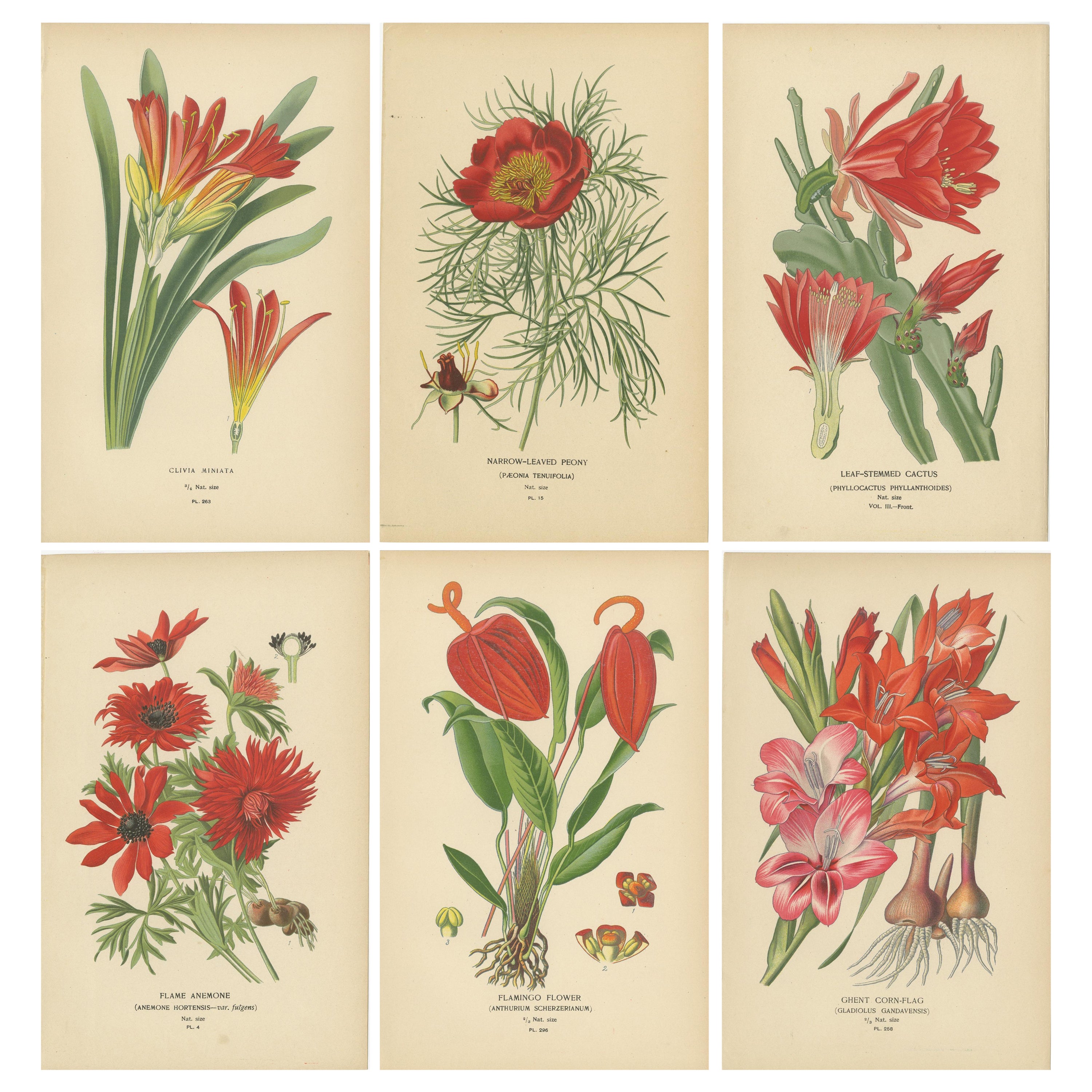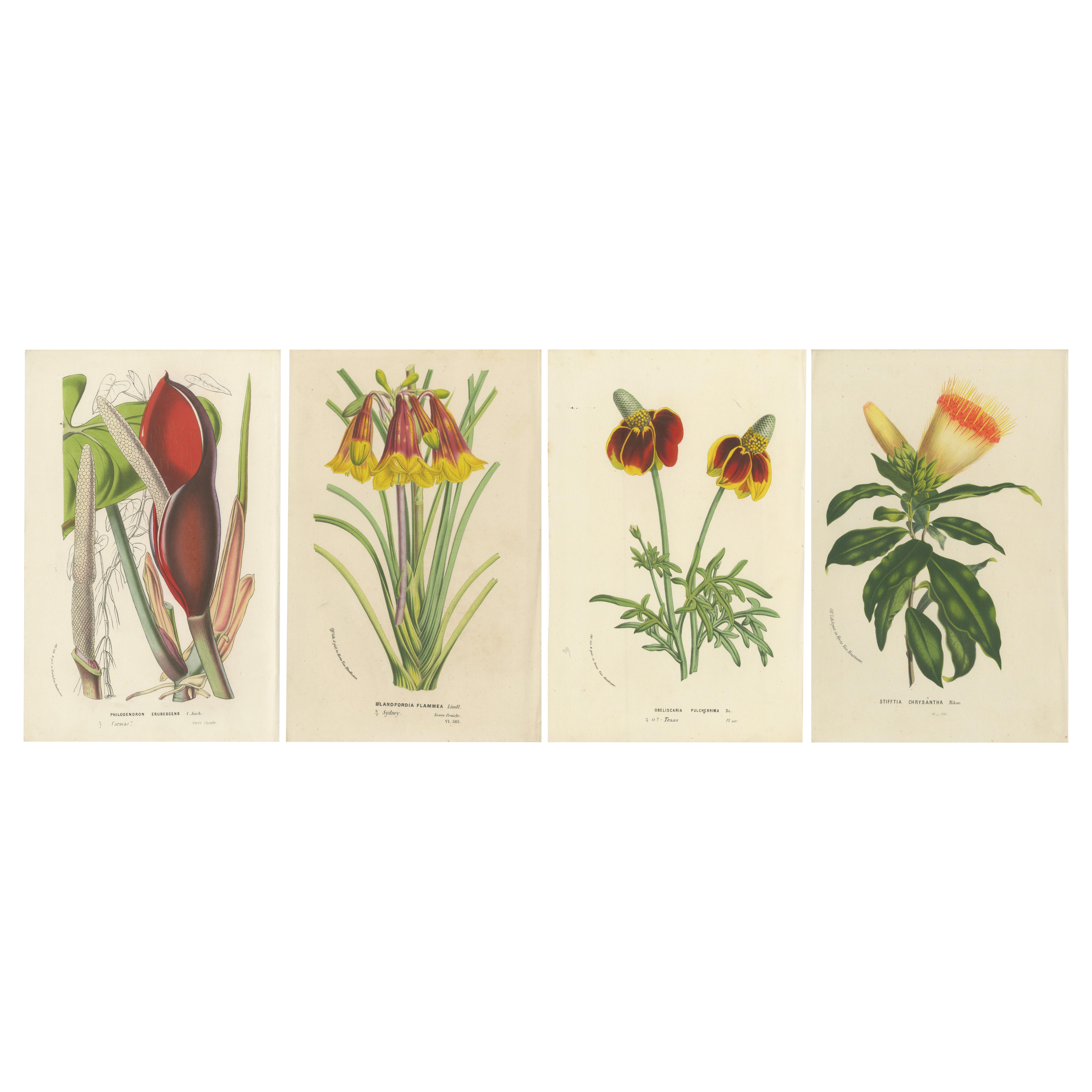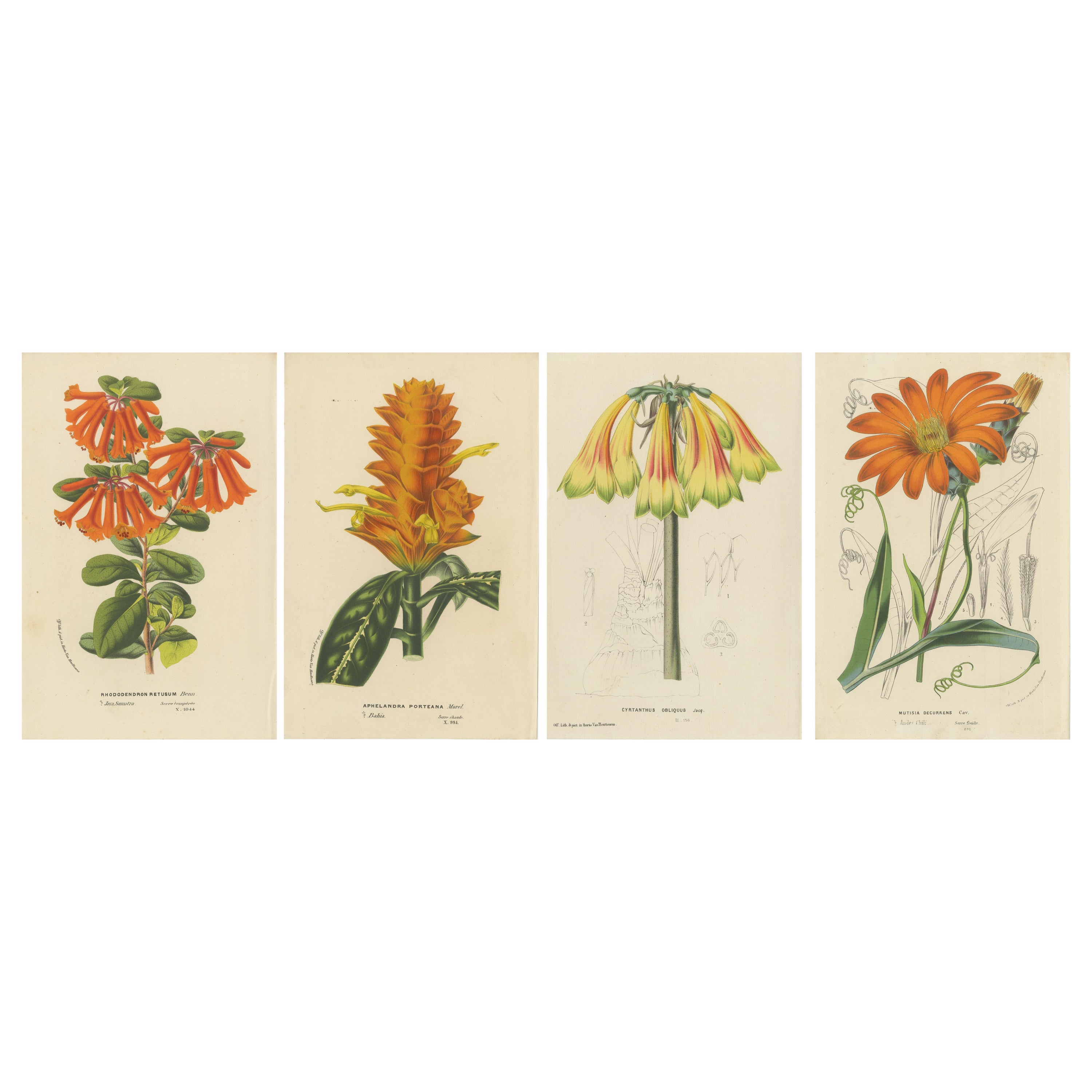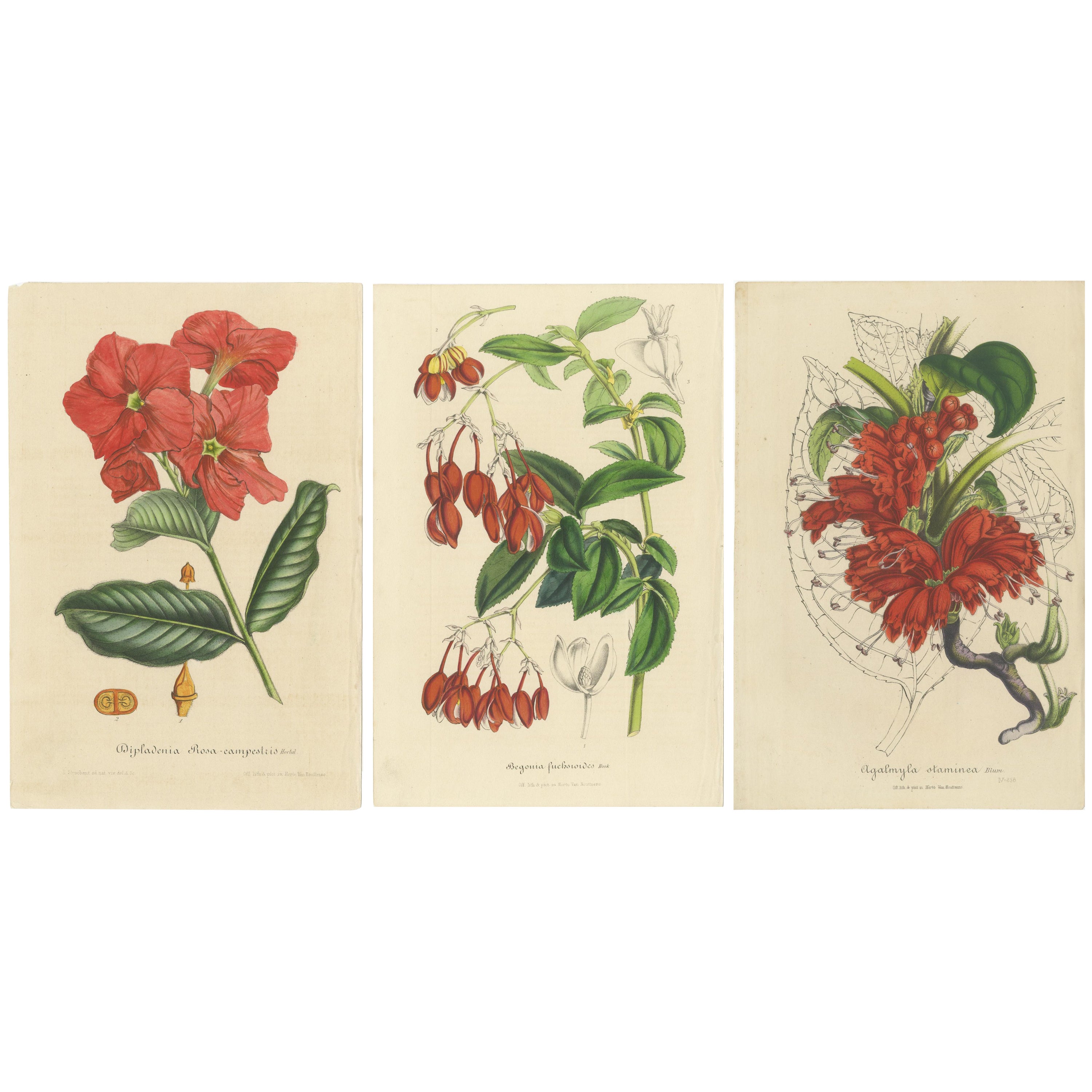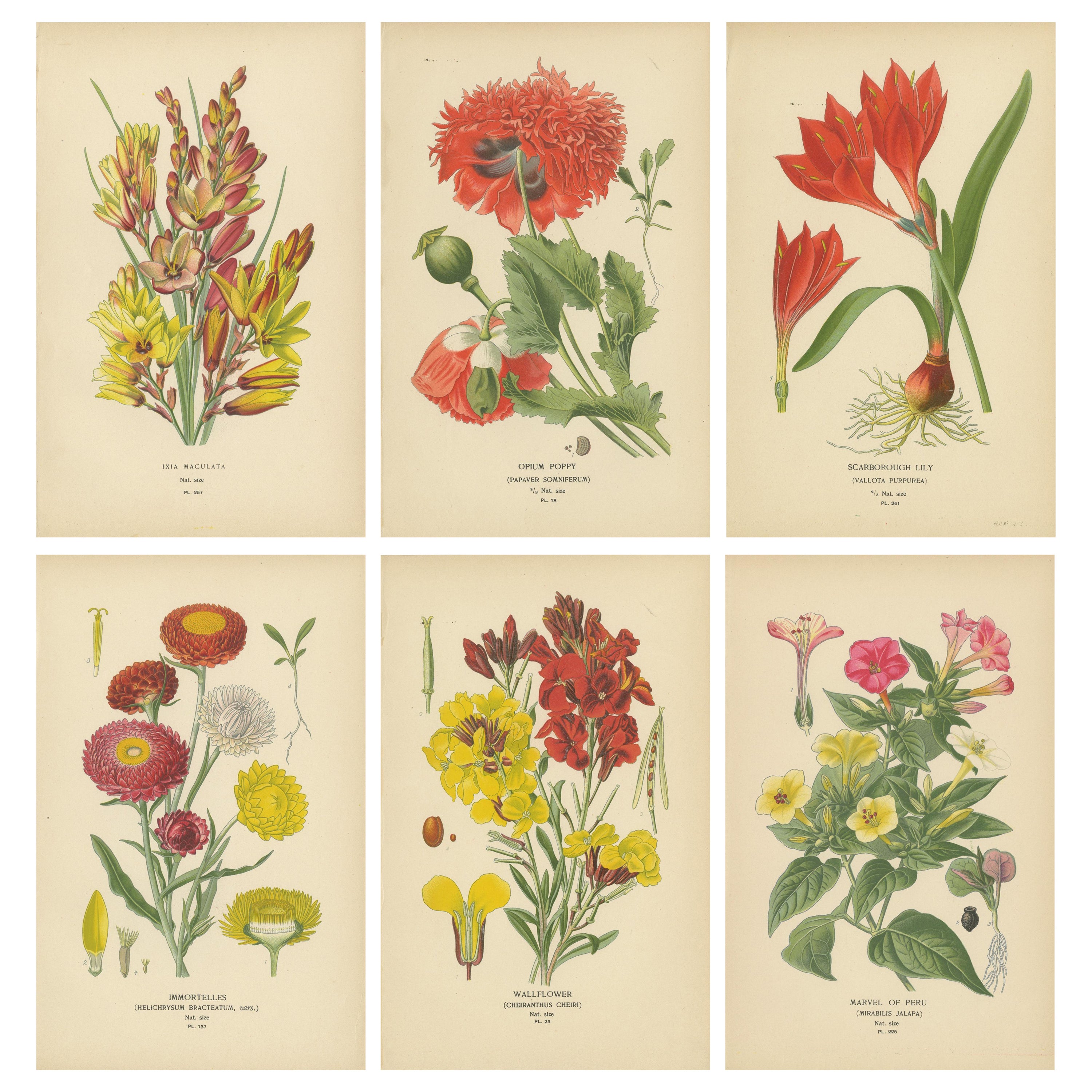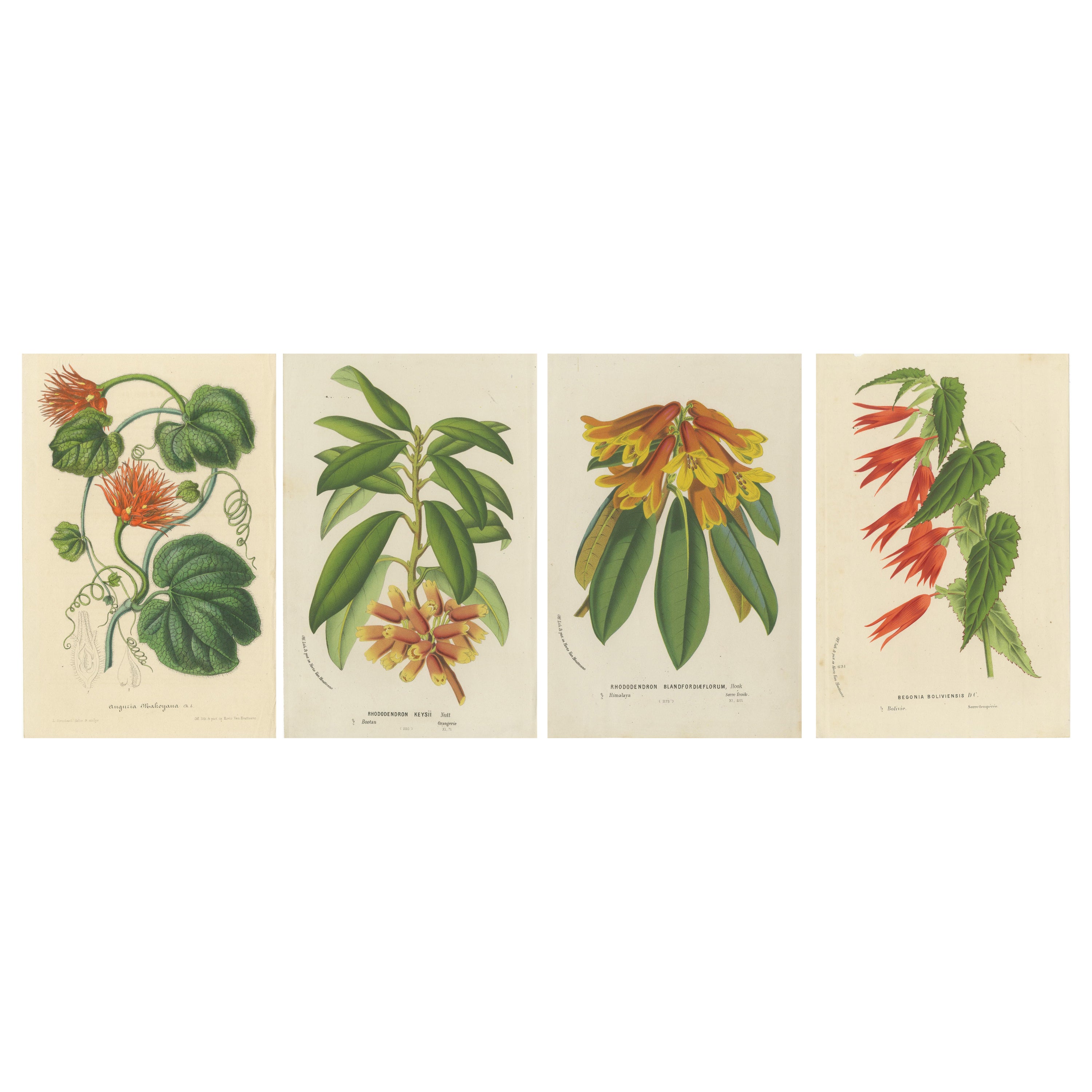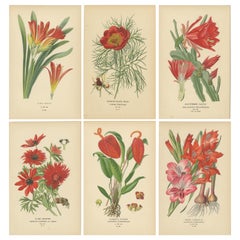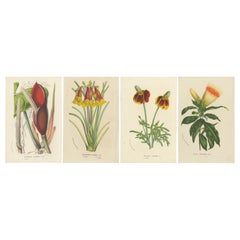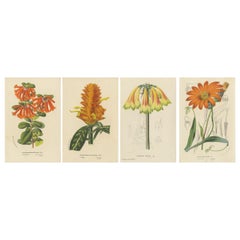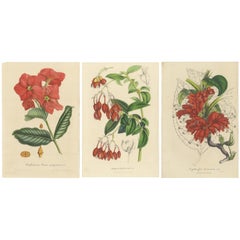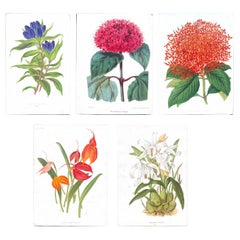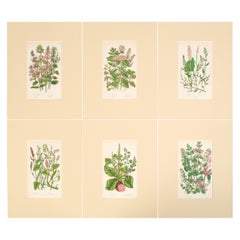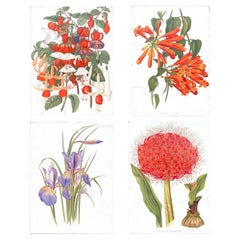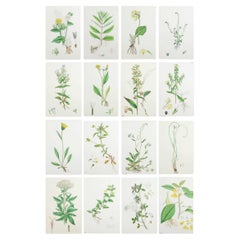Articoli simili a Illustrazioni botaniche originali d'epoca tratte da Revue Horticole, circa 1855
Vuoi altre immagini o video?
Richiedi altre immagini o video al venditore
1 di 10
Illustrazioni botaniche originali d'epoca tratte da Revue Horticole, circa 1855
536 €per set|IVA inclusa
670 €per set20% in meno
Informazioni sull’articolo
Here are descriptions of the eight botanical illustrations, including the Latin and English names of the plants, why they are significant, and details about the creators and the technique used to produce these antique prints.
1. Stanhopea x bellaerensis
- Latin Name: *Stanhopea x bellaerensis*
- Common Name: Stanhopea Orchid Hybrid
- Special Features: This orchid species is known for its striking yellow petals, which are speckled with red-brown spots. Orchids in the *Stanhopea* genus are highly prized by collectors for their complex flower structures and enchanting fragrance. What makes *Stanhopea* orchids particularly interesting is their habit of blooming downward, requiring the flowers to grow through slats or hanging pots, as depicted in the print.
- Artist: L. Descamps-Sabouret
- Technique: Chromolithography, printed by G. Severyns in Brussels.
2. Physalis Franchetii
- Latin Name: *Physalis Franchetii*
- Common Name: Chinese Lantern Plant
- Special Features: The *Physalis* is known for its bright orange, lantern-like husk that surrounds the fruit, making it a popular ornamental plant. The lantern-like structure is actually the enlarged calyx of the flower. The plant is interesting for both its ornamental appeal and its edible fruits, which are enclosed in these colorful, papery husks.
- Artist: L. Descamps-Sabouret
- Technique: Chromolithography by J.L. Goffart in Brussels.
3. Mutisia viciaefolia
- Latin Name: *Mutisia viciaefolia*
- Common Name: Mutisia
- Special Features: This climbing vine is native to the Andean regions of South America. It features bright, red-orange flowers with striking contrast against its fern-like leaves. What makes *Mutisia* interesting is its adaptation to high-altitude environments, where its flowers attract hummingbirds for pollination. Its vibrant color and exotic origin make it a special plant in both horticulture and botanical studies.
- Artist: Godart
- Technique: Chromolithography by G. Severyns.
4. Erigeron aurantiacus
- Latin Name: *Erigeron aurantiacus*
- Common Name: Orange Fleabane
- Special Features: This species is characterized by its vivid orange, daisy-like flowers. It is a perennial plant that is native to Central Asia and is often used in alpine gardens due to its hardiness and striking floral display. The bright orange color is uncommon in the *Erigeron* genus, making this species highly sought after by gardeners.
- Artist: Godart
- Technique: Chromolithography by G. Severyns.
5. Caraguata conifera
- Latin Name: *Caraguata conifera* (now more commonly referred to as *Aechmea conifera*)
- Common Name: Conifer Bromeliad
- Special Features: This plant, a member of the Bromeliad family, is known for its vibrant conical inflorescence with bright red and yellow bracts. Native to tropical regions, it thrives in humid conditions and is an epiphyte, meaning it grows on other plants. Its ornamental and exotic appearance makes it highly valued among collectors.
- Artist: L. Descamps-Sabouret
- Technique: Chromolithography by G. Severyns.
6. Odontoglossum Rossii majus and Sophronitis grandiflora aurantiaca
- Latin Names: *Odontoglossum Rossii majus* and *Sophronitis grandiflora aurantiaca*
- Common Names: Ross's Odontoglossum and Sophronitis Orchid
- Special Features: These two orchids are shown together. *Odontoglossum Rossii* is known for its mottled sepals and petals with intricate color patterns, while *Sophronitis grandiflora* is admired for its fiery red flowers. Both species are rare and highly collectible due to their stunning blooms and difficulty in cultivation. Orchids are particularly fascinating for their intricate reproductive structures, which have evolved to attract specific pollinators.
- Artist: Godart
- Technique: Chromolithography by G. Severyns.
7. Tritoma nobilis
- Latin Name: *Tritoma nobilis* (now commonly referred to as *Kniphofia nobilis*)
- Common Name: Red Hot Poker
- Special Features: This striking plant, native to South Africa, is known for its tall flower spikes that transition in color from bright red at the top to yellow at the base, resembling a torch. The vibrant colors attract hummingbirds and other pollinators. The plant is particularly interesting for its heat tolerance and dramatic appearance in gardens.
- Artist: Godart
- Technique: Chromolithography by G. Severyns.
8. Neumannia arcuata
- Latin Name: *Neumannia arcuata*
- Common Name: Neumann's Orchid
- Special Features: This epiphytic orchid is known for its slender red bracts and green foliage. It is native to tropical rainforests, where it clings to trees and other surfaces. Orchids like *Neumannia arcuata* are fascinating due to their ability to grow in the canopy of the rainforest, surviving on minimal soil and absorbing nutrients from the air and rain.
- Artist: Coriat
- Technique: Chromolithography by G. Severyns.
Why These Plants Are Special:
- Aesthetic Appeal: The vivid colors, unusual shapes, and textures of these plants make them highly desirable in both horticulture and botanical illustration.
- Ecological Importance: Many of these species are native to tropical and subtropical regions, playing important roles in their ecosystems by providing food and shelter for various pollinators, including hummingbirds, bees, and butterflies.
- Horticultural Value* Many of these plants have been introduced into cultivation due to their ornamental appeal. Their exotic origins and unusual forms make them favorites in gardens and greenhouses around the world.
Artists and Maker:
- L. Descamps-Sabouret, Godart, and Coriat: These botanical artists were notable contributors to the world of scientific illustration in the 19th century. Their work was crucial in helping botanists and horticulturists study, identify, and classify new plant species.
- Chromolithography by G. Severyns, J.L. Goffart: These prints were created using chromolithography, a labor-intensive color printing technique that allowed for rich, multi-colored images to be produced. The process was particularly well-suited to botanical illustrations, as it enabled artists to capture the vivid colors and intricate details of plants. Severyns and Goffart were among the best chromolithographers in Belgium, known for their high-quality prints.
Technique - Chromolithography:
- Chromolithography was a revolutionary color printing technique developed in the 19th century. It involved using multiple stones or plates, one for each color, to build up an image layer by layer. This method allowed artists to create prints with a high degree of color accuracy and detail, making it ideal for botanical illustrations. The process required great skill and precision, as each color had to be aligned perfectly to produce a cohesive and vibrant final image. Chromolithographs were widely used in scientific publications, like *Revue Horticole*, to depict new plant species in an accurate and attractive manner.
- Dimensioni:Altezza: 25 cm (9,85 in)Larghezza: 16 cm (6,3 in)Profondità: 0,02 mm (0 in)
- Venduto come:Set di 8
- Materiali e tecniche:
- Periodo:
- Data di produzione:circa 1855
- Condizioni:Condition: Very good, given age. General age-related toning and/or occasional minor defects from handling. Please study scan carefully.
- Località del venditore:Langweer, NL
- Numero di riferimento:Venditore: BG-13761,-84 BG-13761-86, etc1stDibs: LU3054341456762
Informazioni sul venditore
5,0
Venditore riconosciuto
Questi venditori prestigiosi sono leader del settore e rappresentano il massimo in termini di qualità e design.
Venditore Platino
Venditori Premium con valutazione 4.7+ e tempi di risposta entro 24 ore
Fondazione nel 2009
Venditore 1stDibs dal 2017
2533 vendite su 1stDibs
Tempo di risposta standard: <1 ora
- SpedizioneRecupero del preventivo…Spedizione da: Langweer, Paesi Bassi
- Politica di reso
Alcune parti di questa pagina sono state tradotte automaticamente. 1stDibs non può garantire che le traduzioni siano corrette. L’inglese è la lingua predefinita del sito.
Garanzia di autenticità
Nell’improbabile caso in cui si verifichi un problema con l’autenticità di un articolo, contattaci entro un anno per ottenere un rimborso completo. DettagliGaranzia di rimborso
Se il tuo articolo non corrisponde alla descrizione, è danneggiato durante il trasporto o non arriva, contattaci entro 7 giorni per un rimborso completo. DettagliAnnullamento entro 24 ore
Hai un periodo di tolleranza di 24 ore per annullare il tuo acquisto, senza necessità di fornire spiegazioni.Venditori professionali selezionati
I nostri venditori di livello internazionale devono aderire a rigorosi standard di servizio e qualità, garantendo l’integrità delle inserzioni.Garanzia miglior prezzo
Se scopri che un venditore ha pubblicato altrove lo stesso articolo a un prezzo più basso, applicheremo lo stesso prezzo.Consegna globale affidabile
La nostra rete di vettori leader del settore offre opzioni di spedizione specializzate in tutto il mondo, inclusa la consegna personalizzata.Altro da questo venditore
Mostra tuttoIllustrazioni botaniche dell'epoca vittoriana: Una celebrazione visiva della flora
Si tratta di vivaci cromolitografie tratte da "Favourite Flowers of Garden and Greenhouse" di Edward Step, illustrate da Désiré Boi e pubblicate nel 1896 da Frederick Warne & Co., Lo...
Categoria
Di antiquariato/d’epoca, Anni 1870, Stampe
Materiali
Carta
392 € Prezzo promozionale / set
20% in meno
Flora Illustrata: Una collezione di arte botanica del XIX secolo, pubblicata nel 1875 circa.
Le stampe raffigurano varie specie botaniche, ognuna illustrata con un'attenzione dettagliata alla morfologia delle piante, comprese foglie, fiori e talvolta frutti o semi. Queste il...
Categoria
Di antiquariato/d’epoca, Anni 1870, Stampe
Materiali
Carta
272 € Prezzo promozionale / set
20% in meno
Ritratti botanici vibranti: Illustrazioni di piante squisite del XIX secolo
Queste illustrazioni, eseguite con precisione e ricchezza di colori, sono ottimi esempi di cromolitografia, una tecnica popolare nel XIX secolo per la sua capacità di produrre immagi...
Categoria
Di antiquariato/d’epoca, Anni 1870, Stampe
Materiali
Carta
304 € Prezzo promozionale / set
20% in meno
Illustrazioni botaniche di pregio dalla rivista botanica di Curtis (1847)
Queste bellissime illustrazioni botaniche colorate a mano, disegnate e litografate dal famoso artista Walter Hood Fitch, sono state pubblicate nel *"Curtis's Botanical Magazine "* di...
Categoria
Di antiquariato/d’epoca, Anni 1840, Stampe
Materiali
Carta
344 € Prezzo promozionale / set
20% in meno
Tesori floreali: Cromolitografie del XIX secolo dalla Collezione Botanica
Le sei cromolitografie che seguono fanno parte di una raccolta pubblicata nel 1896, creata da Désiré Boi e Edward Step. Illustrano soggetti botanici con una notevole attenzione ai de...
Categoria
Di antiquariato/d’epoca, Anni 1890, Stampe
Materiali
Carta
432 € Prezzo promozionale / set
20% in meno
Lussureggiante e vibrante: Una collezione di illustrazioni botaniche esotiche, circa 1875
Le stampe ritraggono una selezione di piante esotiche con un dettaglio notevole e colori vibranti, mostrando la bellezza e la diversità della vita botanica. Ogni illustrazione è una ...
Categoria
Di antiquariato/d’epoca, Anni 1870, Stampe
Materiali
Carta
328 € Prezzo promozionale / set
20% in meno
Ti potrebbe interessare anche
Bignonia venusta - Cromolitografia botanica antica, anni 1880
Una straordinaria stampa botanica originale del 1880 con la Bignonia venusta, nota anche come vite della fiamma o vite a tromba arancione. Questa illustrazione dai colori brillanti c...
Categoria
Di antiquariato/d’epoca, XIX secolo, Francese, Stampe
Materiali
Carta
Set di sei incisioni botaniche inglesi del XIX secolo, Inghilterra, 1880 ca.
Set di sei incisioni botaniche inglesi del XIX secolo, Inghilterra, 1880 circa.
Montato, pronto per essere incorniciato.
Esemplari di pregio, in ottime condizioni commisurate a...
Categoria
Di antiquariato/d’epoca, Fine XIX secolo, Inglese, Vittoriano, Stampe
Materiali
Carta
Stampa botanica originale del 1880 dell'Hæmanthus Kalbreyeri - Vibrante cromatografia antica
Questa stampa botanica, un'impressionante cromolitografia originale del 1880, raffigura lo spettacolare Hæmanthus kalbreyeri, noto anche come giglio sanguigno. Caratterizzata da una ...
Categoria
Di antiquariato/d’epoca, XIX secolo, Francese, Stampe
Materiali
Carta
Set di 16 stampe botaniche originali antiche, circa 1850
Splendido set di 16 stampe botaniche
Litografie tratte dai disegni botanici originali di Hooker.
Colore originale
Pubblicato, circa 1850
Senza cornice.
La misura indicata è per ...
Categoria
Di antiquariato/d’epoca, Anni 1850, Inglese, Primo vittoriano, Stampe
Materiali
Carta
Set di 6 stampe botaniche originali antiche, circa 1870
Grazioso set di 6 stampe botaniche
Cromolitografie
Colore originale
Pubblicato, circa 1870
Senza cornice.
La misura indicata è per una stampa.
Spedizione gratuita
Categoria
Di antiquariato/d’epoca, Anni 1870, Inglese, Vittoriano, Stampe
Materiali
Carta
Primo Novecento, Stampe botaniche italiane
Inizio del XX secolo, Stampe botaniche italiane. 8 Disponibile.
Categoria
